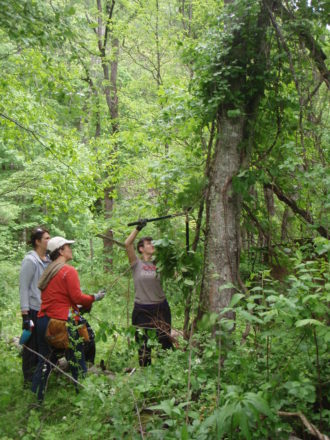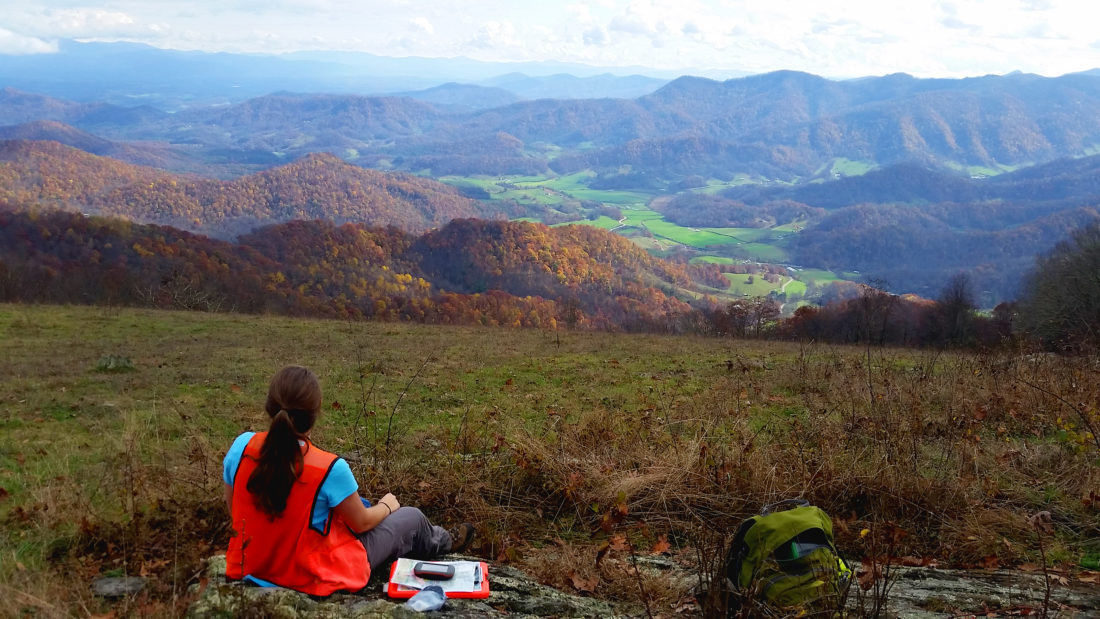The last time Sandy Mush faced a major environmental crisis, it was radioactive waste. In 1986, residents of the rural valley to the northwest of Asheville learned that their region was being considered as the East Coast’s repository for spent nuclear power plant fuel and other hazardous materials. Local activists made it clear that they wouldn’t let their home become a radioactive dump without a fight, and ultimately, another location was chosen.
Now, Sandy Mush’s more than 50,000 acres of farms, forests and protected conservation land face another environmental problem: invasive plants, species introduced to the region that spread quickly and outcompete or outright kill native plants. And while this issue may not grab the same headlines as nuclear waste, it is all the more insidious because it has been largely ignored.
“I’ve seen places where a whole acre of protected forest has been completely killed by invasive plants,” says Andy Tait, director of local sustainable forestry organization EcoForesters.
According to Tait, unsustainable forestry practices have led to a crisis of invasives in Sandy Mush and across Western North Carolina. To combat the encroachment, EcoForesters and two other nonprofits — the Forest Stewards Guild and the Southern Appalachian Highland Conservancy — are seeking funding for educational outreach programs and plant-removal efforts.
A long campaign
Invasive plants thrive in Sandy Mush for the same reason that the farmers have: The region has extremely fertile soil, and it gets a lot of rain. As farmers and developers cut down trees and tilled the soil, the seeds of exotic plants, often carried by birds and running water, were able to spread and take root.
“Sandy Mush is recovering from a long history of heavy timber harvests, the loss of the American chestnut, fire exclusion and agriculture,” says Sarah Sheeran, SAHC’s stewardship associate. “Together, these factors create conditions ripe for the invasion of non-native species, which can threaten forest productivity as well as inhibit the regeneration of native species.”

Invasives also have a long history in region, with many taking root for the first time at Asheville’s Biltmore Estate over 100 years ago. Tait notes that Biltmore landscape architect Frederick Law Olmsted planted Asiatic bittersweet, now known as an aggressive competitor in American environments, along the 3-mile drive up to the estate’s front doors.
“[Biltmore Estate] wanted to have the most exotic plants around, and those plants were not native, so they were intentionally imported there for that reason,” Tait says of Southeast Asian species such as bittersweet, multiflora rose and tree of heaven. “Some of those exotic plants escaped.”
Although the area’s climate is agreeable for these species, WNC hosts none of the diseases or parasites that check their growth on their home turf. “Every single tree has a specific insect to attack that tree and keep it from taking over, to keep things in balance,” explains Tait. “There’s no balance with invasive plants here, so they are growing really rapidly.”
And when these invasives reach into productive “rich coves” like Sandy Mush, they can choke out much of the region’s native biodiversity. Endangered and sought-after plants such as yellow mandarin, black cohosh, blue cohosh and wild ginseng, as well as thousands of other species of native plants and animals, can be at risk.
“This region is the second-most biodiverse region in the world outside of the tropics — and in the Southern Appalachians, these rich-cove forests are the most diverse type,” says Tait. “There’s a tremendous diversity of plants out there that are being impacted by these invasive species.”
Allies in the fight
Tait hopes that the residents of Sandy Mush will unite against the problem of invasive plants just as they did against the threat of becoming a nuclear disposal site. He says that without the help of the community and commitments from local landowners to use sustainable forest management practices when harvesting their trees, even the area of Sandy Mush managed by the SAHC will most likely be lost to the encroachment of exotic plants.
“Invasives don’t obey property boundaries,” says Tait. When a landowner decides to do a timber harvest without invasive plant management, he explains, the upturned soil and added sunlight give those invasives a bigger hold on the forest. If that property is adjacent to a conservation site, the protected land will be affected as well.

Most people, Tait explains, want to do the right thing when it comes to sustainable forestry but balk at the seemingly exorbitant costs of invasive plant management, which often include a costly combination of manual and mechanical removal, herbivory through goats and herbicide application. He estimates that all this work can run roughly $250 an acre.
“There are about 8,000 acres in conservation land out [in Sandy Mush] — about half of it has invasive plants on it, so that’s 4,000 acres. That’s $1 million to go in and treat all the invasives,” Tait says. “Even if you have 20 acres, that’s $5,000.”
But while those figures may seem daunting, Tait points out that the average revenue from a timber harvest is $1,000 per acre, and tax breaks exist for those who do the job right. He adds that harvesting timber with an eye toward invasives in the present will allow the forest to continue to grow in value rather than degrade over time.
“If you wanted to do any timber management, the economic value isn’t going to be there if invasive plants take over. They are going to greatly damage the timber value out there, so there’s actual monetary losses being caused,” Tait says.
Hold the line
The campaign to save Sandy Mush launched two years ago, and its founders are still trying to work out funding. In the meantime, they remain in the planning phase of the project. The next step will be to talk to the landowners of Sandy Mush and explain the importance of their mission, hopefully requisitioning their help along the way.
“We’ve applied for several grants because we need funding,” says Mary Vann Johnston, outreach coordinator for EcoForesters. “Over the next couple of months, we should be hearing back from a few of them, so hopefully we can begin education and outreach opportunities, and then we can move forward with actually doing something about the invasives.”
Johnston will be hosting events in the Sandy Mush community, connecting interested landowners with each other, teaching classes about sustainable forestry and identifying where to look for invasive plants and what they look like.
“If you don’t know what an invasive species is, you won’t know if you have a problem on your property,” says Johnston. “Just because it’s green doesn’t mean it’s healthy.”
Yet the campaigners understand that, to a large degree, their work is one of control rather than elimination. They now consider the region’s ecosystem a “novel environment,” unchangeably altered by the introduction of new species.
“We used to talk about getting things back to a pre-Columbian state, but these non-native invasives are here to stay — we can never go back,” says Tait. “They produce millions of seeds that last for 5 to 10 years sometimes, so even if you killed every plant, they would still come back.”
While this seems like discouraging news, Tait says that if landowners value their forests for their wildlife, aesthetics, recreation, clean water and timber, they need to understand that what farmers and gardeners know about the fields is just as true about the forest: If it gets overgrown, it dies.
“You need to tend your forest like you weed your garden if you want it to produce what you want,” says Tait. “If everyone sees how invasives are affecting their community and that invasives don’t stop at property lines, hopefully people will band together to tackle the problem by working together.”






My husband and I live in Sandy Mush – how do we get involved?
Hi Natalie, I’d reach out to Mary Vann Johnston with EcoForesters — she should have the latest information about the public-facing aspects of the organization’s work. She can be contacted at (828)-484-6842 or info@ecoforesters.org.